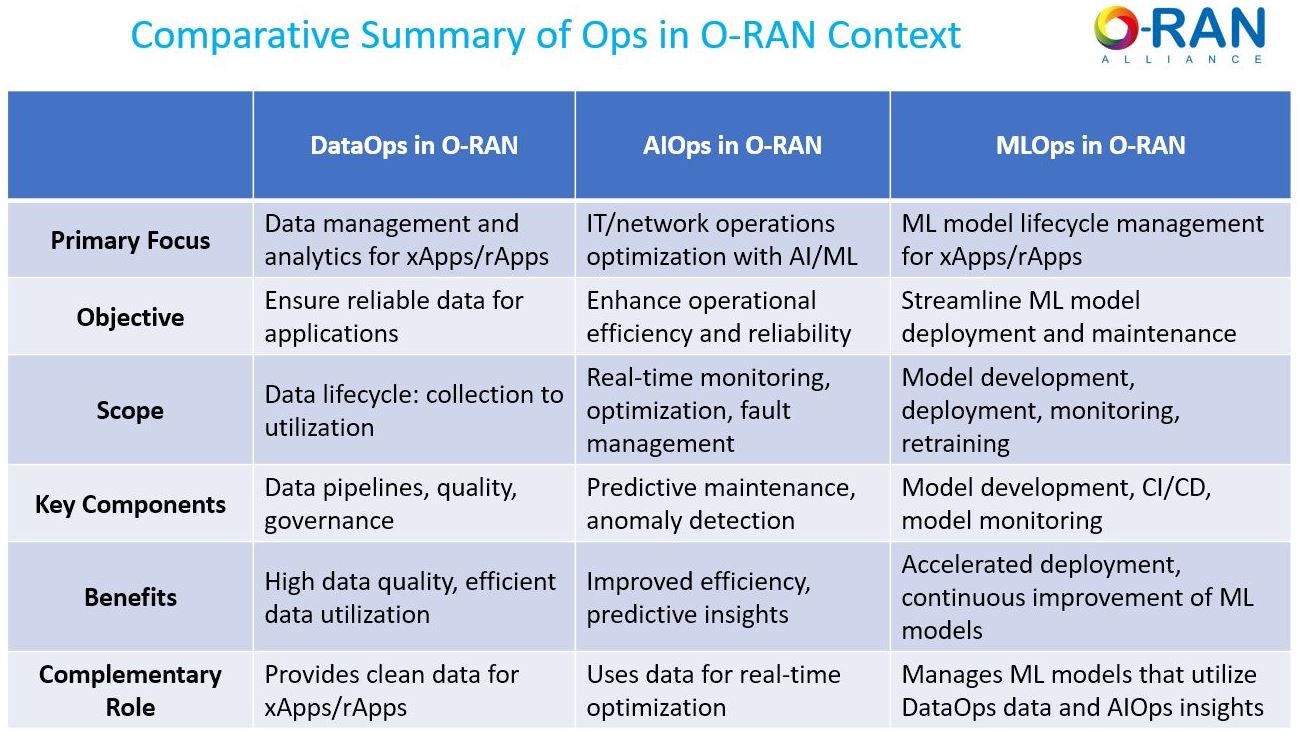O-RAN Operations with DataOps, AIOps, and MLOps
Open Radio Access Network (O-RAN) is a significant innovation in the telecommunications industry, aiming to create more open, intelligent, and interoperable mobile networks. Integrating DataOps, AIOps, and MLOps into O-RAN is critical to achieving efficient and effective network management operations. These practices ensure that xApps and rApps within the RAN RIC operate with high levels of accuracy, performance, and reliability.

Table of Contents
DataOps in O-RAN
DataOps focuses on improving the communication, integration, and automation of data flows between data managers and data consumers across an organization. DataOps ensures that xApps and rApps within the RIC have access to clean, high-quality data, essential for accurate analytics and decision-making. DataOps focuses on data management and governance, enabling the seamless collection, processing, and distribution of data across the network. By implementing standardized data collection methods, robust data pipelines, and stringent data quality checks, DataOps provides the foundation for reliable and timely data that xApps and rApps need to function optimally. In the context of O-RAN:
- Data Pipeline Management: Ensures the smooth and efficient flow of data from various network elements (antennas, base stations, etc.) into the O-RAN management systems.
- Data Quality and Governance: Implements practices to ensure data accuracy, consistency, and reliability, crucial for making informed decisions in network management.
- Real-time Data Processing: Facilitates real-time data collection and processing, enabling immediate insights and actions, which is critical for dynamic network environments.
- Key Benefits:
- Provides xApps and rApps with clean, high-quality data.
- Enhances the reliability and efficiency of data-driven decision-making.
- Supports scalable and secure data management practices.
AIOps in O-RAN
AIOps uses artificial intelligence to enhance IT operations, often through big data, machine learning, and other analytics technologies. AIOps applies AI/ML techniques to monitor and manage network operations proactively. Automated monitoring and alerting systems detect anomalies and trigger preemptive actions, while predictive maintenance algorithms forecast potential failures, allowing for timely interventions. Applying AIOps in O-RAN involves:
- Predictive Maintenance: Utilizes AI to predict and prevent network component failures before they occur, reducing downtime and maintenance costs.
- Anomaly Detection: Identifies unusual patterns in network traffic or performance, allowing for quick detection and resolution of issues such as security breaches or performance bottlenecks.
- Automated Incident Response: Employs AI to automatically respond to incidents, reducing the need for human intervention and accelerating resolution times.
- Key Benefits:
- Improves operational efficiency by automating routine tasks and proactive maintenance.
- Enhances network performance and reliability through continuous optimization.
- Reduces downtime and improves fault management with automated remediation processes.
MLOps in O-RAN
MLOps focuses on the deployment, management, and scalability of machine learning models. MLOps streamlines the deployment, monitoring, and maintenance of machine learning models. By establishing CI/CD pipelines, MLOps ensures that models are regularly updated and tested. Continuous monitoring tools detect performance drifts, and automated retraining processes keep models accurate and relevant, thereby supporting the adaptive capabilities of xApps and rApps. In O-RAN:
- Model Deployment and Lifecycle Management: Ensures that machine learning models used for optimizing network operations are easily deployable and maintainable across different network components.
- Continuous Integration and Continuous Deployment (CI/CD): Applies CI/CD pipelines to machine learning models, ensuring they are continuously tested, validated, and updated as new data becomes available.
- Scalability and Performance: Ensures machine learning models can scale with the network’s growth and maintain high performance under varying conditions.
- Key Benefits:
- Accelerates the deployment and integration of ML models into the RIC.
- Ensures ML models remain accurate and effective through continuous monitoring and retraining.
- Enhances collaboration and reduces operational overhead in managing ML models.
Integration and Benefits
Integrating these practices within O-RAN architecture involves several steps:
- Data Integration Platform: Establish a robust data integration platform that consolidates data from various O-RAN components and external sources.
- AI and ML Infrastructure: Develop an AI and ML infrastructure that can support the deployment and management of intelligent algorithms and models.
- Automation Tools: Implement automation tools to streamline the DataOps, AIOps, and MLOps processes, ensuring efficient operations and quick adaptation to network changes.
- Monitoring and Feedback Loops: Set up comprehensive monitoring systems and feedback loops to continuously improve the models and operations based on real-time data and performance metrics.
Example Use Cases
- Dynamic Spectrum Management: Using real-time data and machine learning models to allocate spectrum resources dynamically, optimizing network performance and reducing interference.
- Energy Efficiency: Applying AI algorithms to manage and reduce the energy consumption of network elements without compromising performance.
- User Experience Optimization: Leveraging data analytics and machine learning to personalize and optimize the user experience, providing better service quality and reliability.
Challenges and Considerations
- Data Privacy and Security: Ensuring that data used for AI and ML applications is protected and complies with relevant privacy regulations.
- Interoperability: Ensuring that the integration of AI/ML models and DataOps/AIOps/MLOps practices does not compromise the interoperability standards of O-RAN.
- Scalability: Ensuring that the solutions can scale with the increasing complexity and size of the network.
Conclusion
The integration of DataOps, AIOps, and MLOps within the O-RAN framework represents a significant advancement towards more intelligent and efficient mobile networks. By leveraging these methodologies, telecom operators can achieve enhanced operational efficiency, improved network performance, and better user experiences.

